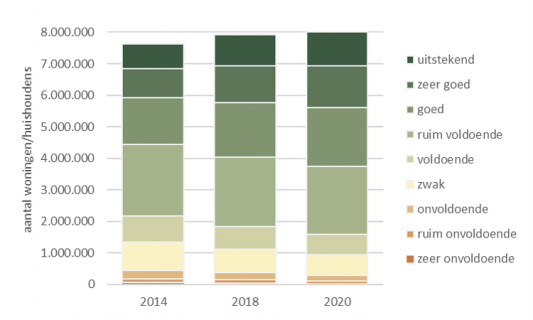The picture shows the average development of the liveability per household in residential neighborhoods in the Netherlands from 2014 (source: Leefbaarheid in Nederland, 2020)
This is the 14th episode of a series 25 building blocks to create better streets, neighbourhoods, and cities. This post discusses how to improve the liveability of neighbourhoods. Liveability is defined as the extent to which the living environment meets the requirements and wishes set by residents.
Differences in liveability between Dutch neighbourhoods
From the image above can be concluded that more than half of all households live in neighborhoods to be qualified as at least 'good'. On the other hand, about 1 million households live in neighborhoods where liveability is weak or even less.
These differences are mainly caused by nuisance, insecurity, and lack of social cohesion. Locally, the quality of the houses stays behind.
The neighborhoods with a weak or poorer liveability are mainly located in the large cities. Besides the fact that many residents are unemployed and have financial problems, there is also a relatively high concentration of (mental) health problems, loneliness, abuse of alcohol and drugs and crime. However, many people with similar problems also live outside these neighbourhoods, spread across the entire city.
Integration through differentiation: limited success
The Netherlands look back on a 75 years period in which urban renewal was high on the agenda of the national and municipal government. Over the years, housing different income groups within each neighbourhood has played a major role in policy. To achieve this goal, part of the housing stock was demolished to be replaced by more expensive houses. This also happened if the structural condition of the houses involved gave no reason to demolishment.
Most studies show that the differentiation of the housing stock has rarely had a positive impact on social cohesion in a neighborhood and often even a negative one. The problems, on the other hand, were spread over a wider area.
Ensuring a liveable existence of the poor
Reinout Kleinhans justly states: <em>Poor neighborhoods are the location of deprivation, but by no means always the cause of it.</em> A twofold focus is therefore required: First and foremost, tackling poverty and a structural improvement of the quality of life of people in disadvantaged positions, and furthermore an integrated neighborhood-oriented approach in places where many disadvantaged people live together.
I have already listed measures to improve the quality of life of disadvantaged groups in an earlier post that dealt with social security. I will therefore focus here on the characteristics of an integrated neighbourhood-oriented approach.
• Strengthening of the remaining social cohesion in neighborhoods by supporting bottom-up initiatives that result in new connections and feed feelings of hope and recognition.
• Improvement of the quality of the housing stock and public space where necessary to stimulate mobility within the neighborhood, instead of attracting 'import' from outside.
• Allowing residents to continue living in their own neighborhood in the event of necessary improvements in the housing stock.
• Abstaining from large-scale demolition to make room for better-off residents from outside the neighborhood if there are sufficient candidates from within.
• In new neighborhoods, strive for social, cultural, and ethnic diversity at neighborhood level so that children and adults can meet each other. On 'block level', being 'among us' can contribute to feeling at home, liveability, and self-confidence.
• Curative approach to nuisance-causing residents and repressive approach to subversive crime through the prominent presence of community police officers who operate right into the capillaries of neighbourhoods, without inciting aggression.
• Offering small-scale assisted living programs to people for whom independent living is still too much of a task. This also applies to housing-first for the homeless.
• Strengthening the possibilities for identification and proudness of inhabitants by establishing top-quality play and park facilities, a multifunctional cultural center with a cross-district function and the choice of beautiful architecture.
• Improving the involvement of residents of neighbourhoods by trusting them and giving them actual say, laid down in neighborhood law.
Follow the link below to find an overview of all articles.





